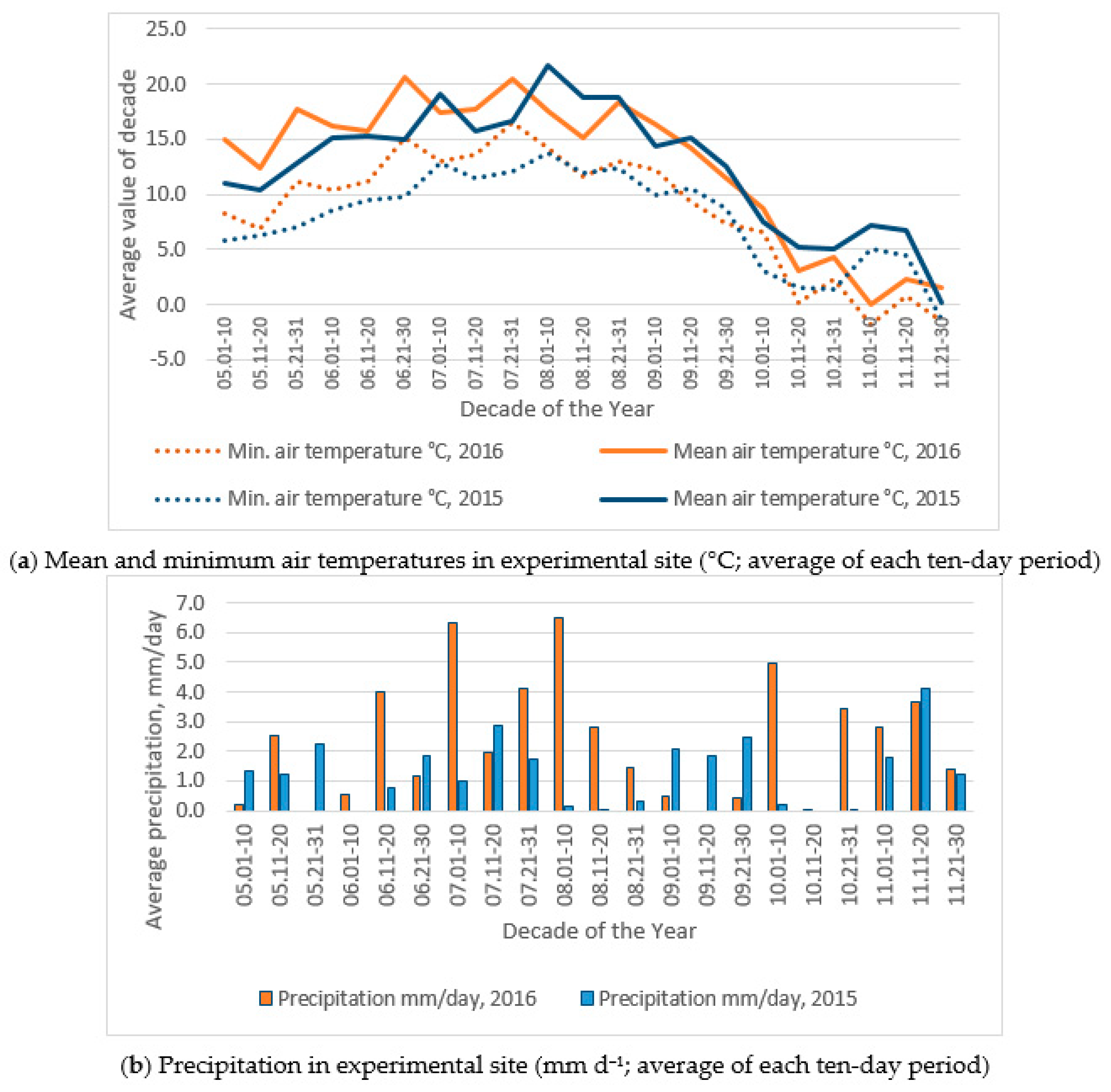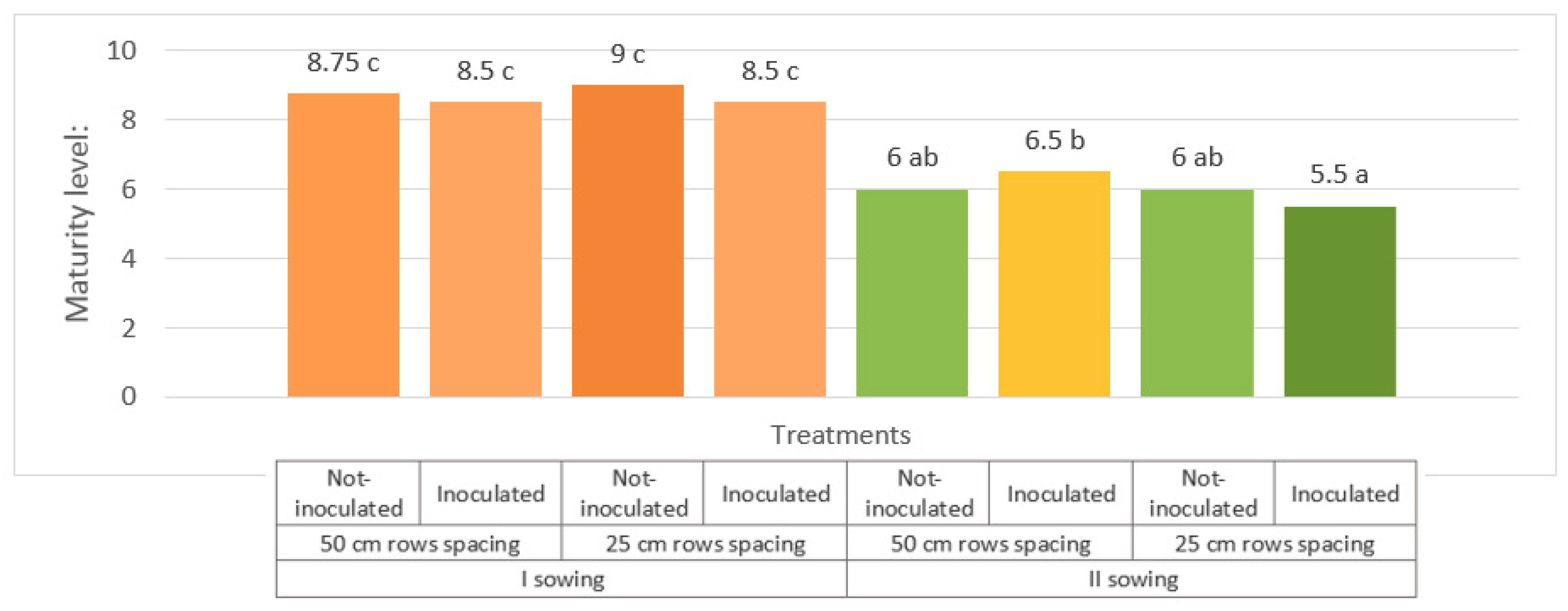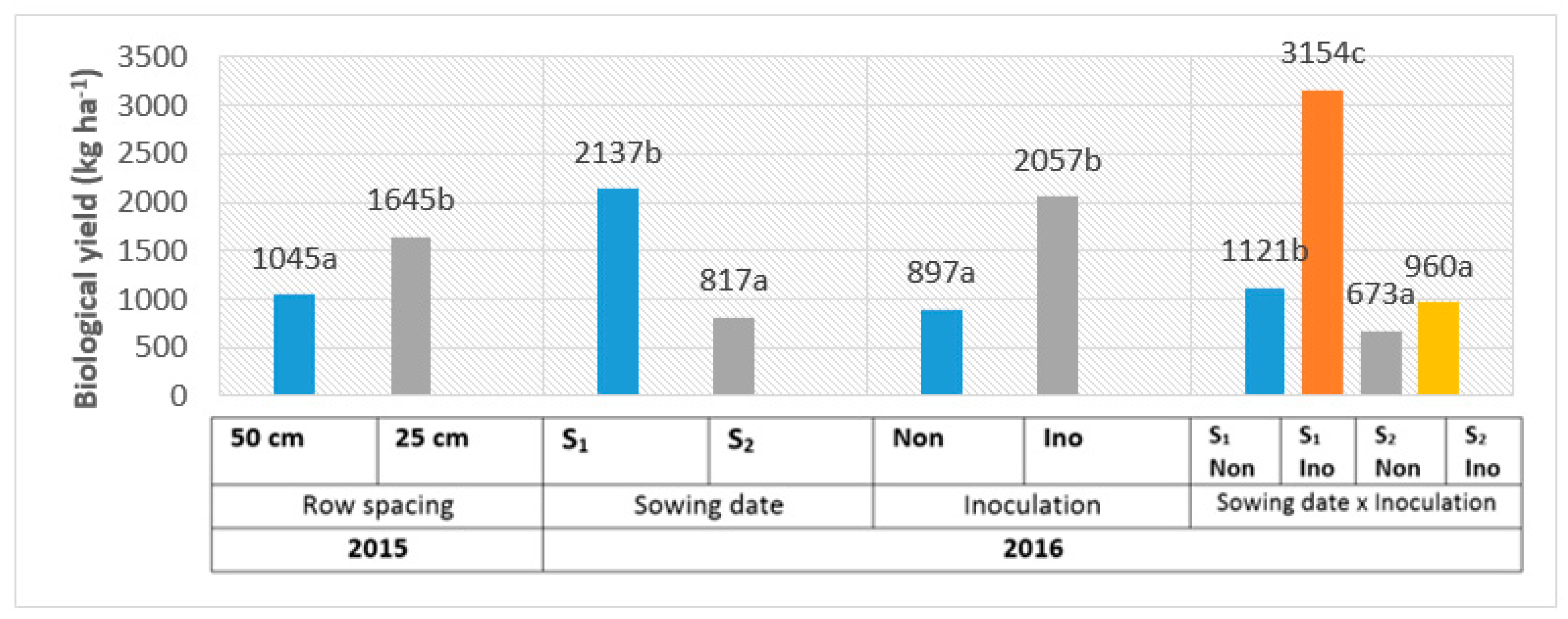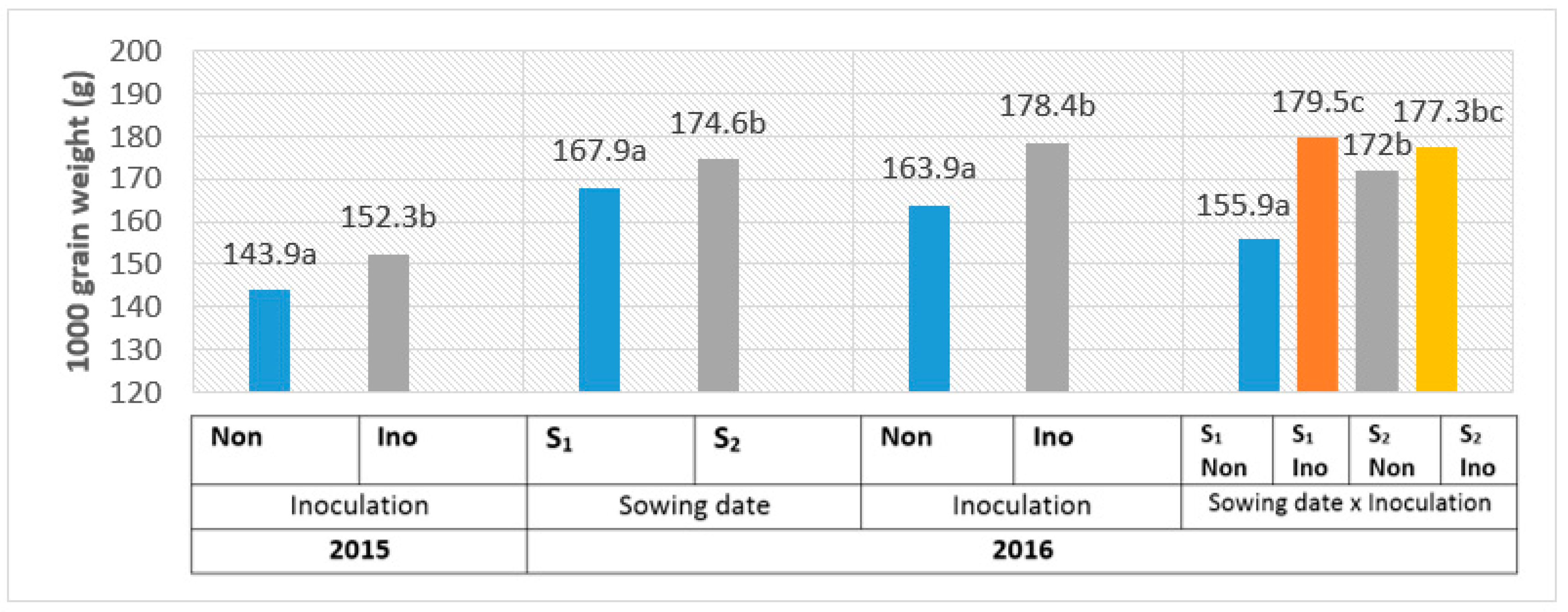1. Introduction
In stockless organic farming systems, legumes are suggested as one of the tools that might alleviate ecosystem shortcomings and reduce nutrient imbalances, but a decrease in legume cropping areas has been observed in most European agriculture with no satisfactory explanation [
1]. In Europe, the ongoing climate change and the high need of domestic non-genetically modified (non-GMO) soybean markets promote the idea of soybean (
Glycine max (L.) Merr.) introduction in typical organic farming systems [
2]. Soybeans can become productive enough to compete with other potentially better adapted species [
3], as well as adjust nutrient cycling [
4,
5], promote environmental biodiversity [
6], enhance organic crop production [
3,
7], and reduce problems caused by pathogens [
2]. The latest research has focused on soybean introduction in cool climate states, such as Germany, Sweden, Denmark, and Norway. The Baltic states are not typical regions for growing soybeans. Therefore, soybean growth, development and environmental conditions should be investigated to gain knowledge about optimal soybean possibilities at high latitudes [
8].
The potential yield of soybean varies geographically due to the changing climate and environmental characteristics [
8]. Several studies report that meteorological conditions are some of the most significant factors affecting soybean growth, development, and productivity [
9,
10,
11,
12]. Temperature and moisture can determine soybean development and production in new regions [
13]. The Baltic Nordic region in Europe is characterized by long days, low temperatures, spring frosts, and short vegetation periods [
14]. Temperature and photoperiods regulate the length of soybean growth cycles [
15]. Earlier maturing cultivars could be adapted to high latitudes [
16]. Cultivars of the 000 maturity group have been tested to function at up to the 59th latitude in southern Sweden [
17].
In organically managed farming systems, management solutions play a decisive role in determining yield components under conditions of the local environments [
18]. Most non-genetically modified soybean cultivars are bred and performance-tested under conventional conditions, but rarely on organic farms [
19]. In organic soybean production, establishment of effective rhizobial symbiosis is crucial for soybean production and overall soil fertility [
20]. Legume inoculation with
Rhizobium strains is a necessary agricultural practice in most European soils, which are free of soybean specific rhizobia [
21]. Soybean plants should be nodulated by specific
Bradyrhizobium japonicum strains to sustain nitrogen fixing efficiency [
22]. Effective inoculation with
Bradyrhizobium strains increases grain yield, protein content, and protein yield [
23]. Efficiency of nitrogen fixation in each region can differ according to the rhizobia genome, environmental factors, as well as different agricultural practices [
24].
In organic farming, selecting the correct combination for a particular inoculum, row spacing, planting date, and maturity group will extend the productive period and maximize soybean yield [
25]. Increasing the row spacing of grain legumes from the traditional 12 cm to 25 or 50 cm allows performing organic interrow cultivation [
7,
26]. Wider row spacing reduces the competition for light [
27], and nutrients, which are often limited in organically managed soils [
4]. Row spacing determines seeding density and population, maximum biomass, the time required for soybean closure and yield [
28]. Often, narrow rows achieve higher net assimilation rates and result in greater seed yields than wide rows [
11]. However, increasing the row spacing may result in a soybean yield penalty and sustain a higher crop yield in the organic systems, where N is less readily available [
29].
Optimal planting dates for soybeans vary according to variety, cropping system, and environmental conditions [
30]. The delay of typical sowing date is one of the organic techniques for effective weed control in the soybean crop [
7]. Thus, late sowing decreases weed cover partially through destruction of early annual weed populations that germinate before harrowing operations [
31], and adjoin to a typically drier late spring period in the Nemoral zone inhibiting weed growth [
14]. However, the suitable date for sowing in areas of cool weather is very short, and this influences yield much more than in warm areas [
11]. Planting prior to or later than the optimal planting date can greatly reduce early maturing soybean yield, and quality, since photoperiodism controls the amount of time available for vegetative plant growth and development [
8]. Soybeans planted prior to this optimum range often lose yield from poor emergence due to inadequate soil temperature. In addition, plants sowed after the optimal range fail to develop fully [
32].
The aim of this study was to assess the impact of natural and management factors on soybean development and productivity in an organic farming system above the natural distributional region. The main objectives were: (i) to evaluate the ability of soybean (Glycine max L. (Merr.)) to perform under northern climate conditions, and (ii) to investigate the effect of inoculation, sowing time, row spacing, and their interaction on soybean productivity.
2. Materials and Methods
2.1. Experimental Site and Conditions
Field experiments were conducted in the 2015 and 2016 cropping seasons at the Lithuanian Centre for Agriculture and Forestry in Akademija (55°23′49″ N 23°51′40″ E), Lithuania. According to Ray et al. (2002), the typical soybean cultivation area in Europe occurs at up to the 49°N latitude. The experimental site was located above the northern boundary of soybean distribution—55°24′ N. Lithuania is in a temperate climatic zone, where the mean annual air temperature is 6.5 °C and the growing season lasts from 169 to 202 days. Weather data were collected at the stationary meteorological station located in Akademija, using the temperature and rainfall sensors (
Figure 1). At the experimental site, the sum of active temperatures (ΣT > 10 °C) is 2100–2200 °C, and the average annual precipitation is 500–600 mm. In both 2015 and 2016, the temperature of growing season was higher than the 1980–2010 average, so the conditions for soybean growth were favorable. However, there was a significant difference between 2015 and 2016 in the amount of precipitation (
Figure 1). The lack of moisture resulted in a few periods of droughts in 2015 (during V1, R3 and R8 soybean growing stages), whereas 2016 could be described as comparable wet.
The soil of the experimental site is a loamy Endocalcaric Epigleyic Cambisol (Drainic, Loamic) CM-can.glp-dr.lo. Characteristics of the soil arable layer (0–25 cm) were: pH 7.2, humus content 2.7%, total nitrogen 117 mg kg−1, available phosphorus (P2O5) 51 mg kg−1 and available potassium (K2O) 68 mg kg−1. Site was managed organically since 2003, with no extra irrigation, pesticides and other chemical contamination. The farming type is exceptionally crop production, where N is supplied by a high variety of grain and forage legume plants, plant-based fertilizers, and microbial substances.
2.2. Experimental Design and Treatments
Three management factors, relevant for organic soybean farming, were investigated: (i) inoculation with B. japonicum and no inoculation; (ii) two wide row spacings—50 cm and 25 cm; (iii) two delayed sowing times (the first as soon as air temperature reached 15 °C and soil temperature reached 5 °C; the second, two weeks after first sowing). Therefore, seeds were sown on 12 May and 25 May 2015, also 20 May and 3 June 2016. In contrast, typical row spacing would be 12.5 cm and typical sowing time would cover from 15 April to 7 May. Eight treatments were conducted as the interaction of all three variables. The experiment was based on a randomized complete block design with four replications. Each plot was 3.0 m wide and 12.0 m in length. The soybean was introduced for the diversification in the sequence of local crop rotation: spring wheat–soybean–spring barley–winter wheat–pea. The replication of soybean experiment in time was conducted at adjacent contiguous field plot. Soybean cultivar Merlin, belonging to an early 000-maturity group, was chosen. All plots were ploughed in an autumn (to a depth of 25 cm) and harrowed for weed control two times: in early spring (April) and day before seed sowing (May–June). Post sowing, weeds were controlled by interrow cultivator (stage V1) and mechanical weed control by hand-sorting (stage R1). The sowing rate was 120 kg ha−1. Half of the seeds were inoculated with B. japonicum; the other half were sown without previous inoculation. The inoculant contained the strain SEMIA5079 (=CPAC 15) of B. japonicum, containing 1.2 × 109 colony forming units (CFU) mL−1. The dose of inoculant was calculated to deliver 1.2 × 106 cells per seed.
2.3. Data Collection
Soybean development was observed and development stages recorded throughout the vegetation period. Plant height was measured on a weekly basis together with the extent of nodulation. Five plants were selected randomly from each plot and nodules from the root crown were counted and weighed. N-fixation activity was assessed by nodule color; those with pink color were counted as active. Height/length and biomass of plant shoots and roots were determined. Soybean productivity and yield components were determined for a 4 × 0.25 m2 sample area in each plot. Data collected for samples were soybean plant density, root length, and shoot height, root and shoot dry biomass, number of productive branches, and pods per plant, seed number, and seed weight for each plant and pod. Grain quality was indicated by 1000 grain weight, content of protein, fat, and moisture. All samples were taken from each plot.
Soybean maturity was evaluated in R7–R8 (beginning maturity – full maturity) stages on 17 October 2016. Each plot was rated on a 10-score system according to phenological signs of maturity of most plants in each plot. The lowest maturity level recorded was 5 and the highest 10, based on the following: 5—plants green, with green and yellow leaves, stems still green, pods green and yellow, beans green and soft; 6—majority of plants yellow-brown, leaves brown, stems green, pods green and yellow, beans still green, wet and soft; 7—majority of plants brown, leaves brown, stems green, all pods yellow but not cracked, beans yellow, wet and soft; 8—plants brown without leaves, stems brown, pods yellow and hardly cracked, beans yellow and harder, but finger crushed and wet; 9—plants brown without leaves, stems brown, pods yellow, medium cracked, beans yellow and harder, with some moisture left; 10—plants brown without leaves, stems brown, pods yellow and easily cracked, beans yellow, hard, oval, and dry.
2.4. Data Analysis
Statistical analysis of soybean yield and traits was performed using a three-way RCB ANOVA on statistical program SAS Enterprise 7.1 computer software. The sources of variation were differences between groups (three main factors; eight treatments) and within groups (four replications for each treatment). The main factors for statistical analysis were sowing time, row spacing and with/without inoculation. The combined analysis of the interactions of factors was performed, too. Means for significant effects were separated using Duncan’s multiple range tests at the 5% probability level (p < 0.05). Homogeneity and normality were verified using Bartlett’s test.
5. Conclusions
The present study shows that soybean cultivar from an early maturity group can fully develop above the northern boundary of soybean distribution. Organic management practices, namely inoculation of seeds with B. japonicum, delayed sowing time, wide row spacings and interaction of these factors have the significant effects on soybean development and productivity in new regions.
In a comparable dry 2015 year, 25 cm spaced rows significantly increased plant density and, therefore, grain yield. However, inoculated soybean plants cultivated in 50-cm spaced rows gained on average 35% more biomass, 29% more pods, and 36% higher seed yield per plant than those cultivated with 25 cm spacing.
Contrarily, inoculation, sowing time, and interaction of them had a significant effect on grain yield in a comparable wet 2016 year. In the wet year, inoculated soybean accumulated a high number of nodules and inoculation increased seed yield per plant, by 98%, averaging two sowing dates. Seeds sown two weeks earlier accumulated 30% greater biomass, more pods, and 67% more seeds yield per plant than those sown later.
The interaction of management practices gave the additional value to soybean quality. Non-inoculated soybeans had an average of 31% of protein, while inoculated 34%. Only applying inoculation in combination with appropriate sowing time produced protein content higher than 35%.
This study demonstrates that use of different management practices in organic farming can cause yields to vary from 673 to 3154 kg ha−1 and greatly affect soybean quality above the northern boundary of soybean distribution.












